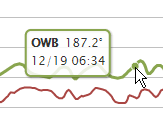
The page has minimal description because it's principally intended for my own use, to provide realtime monitoring of my house's heating system.
But I've found that other people find the page, and they don't understand what they're seeing. This page attempts to describe it.
Here's an overview of the screen:

It's divided into three areas: Zones, Thermometers, and Chart
| AIR | This is the outside air temperature. It's a good indicator of how much heat the house will need. |
| OIL | This is the temperature of the heating water as it exits the oil boiler. When we're not burning oil, this temperature is driven by the heat coming from the Outdoor Wood Boiler, and the temperature gradually rises and falls. When we do burn oil, this temperature rises and falls dramatically (see below). |
| OWB | This is the temperature of the heating water as it enters the house from the outdoor wood boiler (OWB). The boiler itself maintains a water temperature between 170° and 190° (when the water temp hits 170, the boiler fires up; when the temp hits 190 the boiler shuts down). |

When a thermometer's temperature changes, it will change color for 2 seconds.
When the temp increases, the thermometer will be red; when the temp decreased it will show blue.
A gray thermometer indicates that the temperature hasn't recently changed.
Most of the house has infloor radiant heating - the PEX tubes are attached to the underside of the floor. This provides nice, even, invisible heat. Other parts of the house (the bedrooms) have baseboard radiators. All are heated by pumping hot water thru the tubes and/or radiators.
As a part of this project, I was curious to know how often and for how long the zones turn on - I wanted to know exactly how much heat the various areas of the house are consuming. Eventually I'm hoping to be able to conserve energy by reducing the amount of heat used in the most demanding zones.
So, each round rectangle on the left represents one zone.
There are three bits of information for each zone: Name, State (on/off), and Duration.
| Zone Name | Some are obvious (MBR=Master Bedroom), some are not (FROG=Finished Room Over the Garage... my office). |
| State | The background color of the rectangle tells you it's state: - Gray means the zone is off... it's not currently consuming any heat. - Green means the zone is on... the heating system is currently pumping hot water to this area of the house. If you watch the page for any length of time, you'll see the various zones turn on and off. They're on less often during the day and/or when it's warm outside, and on more often during the night and/or when it's cold outside. |
| Duration | When the Zone is on (green background), this indicates how long the zone has been on. When the Zone is off (gray background), this indicates how long the zone was on before it turned off. |



